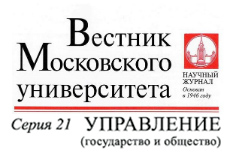Artificial Neural Networks as a Tool for Economic Development Planning
Keywords:
Planning, digital economy, government regulation, artificial neural networks, strategic planning, macroeconomicsAbstract
Mathematical models that simulate the networks of nerve cells of living organisms are actively used for forecasting purposes, but they have the potential in terms of planning. Artificial neural networks may be of interest as a platform for managing economic processes. The article examines evolution of economic development planning, explores the possibilities of using artificial neural networks for planning purposes from economic cybernetics point of view. The author relies on the definition of a plan as an algorithm of actions coordinated in time and space, capable of transforming the system. Neural networks were compared with the basic laws of cybernetics in the article, different types of neural networks were demarcated and the purposes of their use were analyzed. It is concluded that feedforward artificial neural networks can only be used for forecasting purposes, since they give a statistical average weighted result, and not exact calculations. Recurrent neural networks can be used for “preplanning” or indicative planning. It is possible to take individual indicators and consider them in dynamics, but this model is fraught with disparities and distortions in production. The author concludes that indicative planning is no longer relevant in complex systems and market diversity. It is shown that the direct and feedback algorithm and the computing apparatus are necessary for directive and strategic planning of the economic development, this is possible only in the case of the synthesis of neural networks and the dynamic model of interbranch-intersectoral balance developed by N.I. Veduta.
References
Ведута Е.Н. Межотраслевой-межсекторный баланс: механизм стратегического планирования экономики. М.: Академический проспект, 2016.
Ведута Е.Н. Стратегия и экономическая политика государства. М.: Академический проспект, 2004.
Ведута Н.И. Социально эффективная экономика. М.: Издательство РЭА, 1999.
Евтянова Д.В. Государственный дирижизм на основе индикативного планирования как концепция устойчивого экономического развития // Устойчивое развитие российской экономики. Сборник статей по материалам V Международной научно-практической конференции / Под ред. М.В. Кудиной, А.С. Воронова. М.: КДУ, Университетская книга, 2018. С. 271–279.
Евтянова Д.В. Критерии создания цифровых платформ управления экономикой // Экономические системы. 2017. Т. 10. № 3(38). С. 54–58.
Зоидов К.Х., Пономарева С.В., Серебрянский Д.И. Стратегическое планирование и перспективы применения искусственных нейронных сетей в нефтегазовой отечественной промышленности // Региональные проблемы преобразования экономики. 2018. № 9(95). С. 15–24.
Кордюков А.В., Рябов А.Н. Методы искусственного интеллекта в задачах планирования производства // Вестник Рыбинской государственной авиационной технологической академии им. П.А. Соловьева. 2017. № 2(41). С. 332–336.
Круглов В.В., Борисов В.В. Искусственные нейронные сети. Теория и практика. М.: Горячая линия. Телеком, 2001.
Лукьянова Н.Ю., Щербинина Л.Ю., Мазанова С.Е., Кубина Н.Е. Нейромоделирование в цифровой экономике: управление инновациями // Управление инновациями: вызовы и возможности для отраслей и секторов экономики / Под ред. А.В. Сербулова. Калининград: Издательство Балтийского федерального университета им. И. Канта, 2019. С. 154–161.
Озеров А.В. Применение технологий искусственного интеллекта в целях планирования боевых действий группировки авиации // Воздушно-космические силы. Теория и практика. 2019. № 9. С. 21–26.
Пономарев В.М., Пономарева С.В., Жигит А.А. Стратегическое планирование, адаптация и применение искусственных нейронных сетей в ракетно-космической промышленности Российской Федерации // Вестник Алтайской академии экономики и права. 2019. № 5-1. С. 128–135.
Степанов М.Ф. Нейронные сети для планирования решения задач теории автоматического управления // Проблемы управления. 2004. № 2. С. 66–71.
Эшби У.Р. Введение в кибернетику. М.: «Иностранная литература», 1959.
Downloads
Published
Similar Articles
- Daria V. Evtyanova, Concept and Principles of Economy State Regulation for Overcoming Economic Crisis in Russian Federation , Public Administration. E-journal (Russia): No. 92 (2022)
- Ilia S. Balakshin, Marketplace Trends and Industry Expertise in Russia , Public Administration. E-journal (Russia): No. 109 (2025)
- Ekaterina A. Panova, Ekaterina Yu. Tarasova , Enhancing of Digital Competencies and Digital Literacy of Civil Servants in the Context of Digital Modernization of Public Administration , Public Administration. E-journal (Russia): No. 112 (2025)
- Gennady L. Kupryashin, Ekaterina S. Drobysheva, Depressed Territories as Objects of Strategic Planning , Public Administration. E-journal (Russia): No. 109 (2025)
- Elena N. Veduta, Liparit A. Gegamyan, Artificial Intelligence in Ensuring Sustainable Economic Development , Public Administration. E-journal (Russia): No. 110 (2025)
- Lydia S. Leontieva, Svetlana V. Avilkina, The Higher Education System as a Strategic Resource for Regional Development , Public Administration. E-journal (Russia): No. 86 (2021)
- Igor N. Molchanov, Natalia P. Molchanova, State Financial Policy of Russia: Features of Development and Implementation in New Geopolitical Conditions , Public Administration. E-journal (Russia): No. 100 (2023)
- Matvey S. Oborin, Mechanisms for Stimulating Innovative Development of Single-Industry Towns in Arctic Territories , Public Administration. E-journal (Russia): No. 91 (2022)
- Anna S. Titova, Maria A. Sukhareva, Alexey I. Fedoseev, Analysis of Community Approaches in Digital Economy Field and Its Social Implications , Public Administration. E-journal (Russia): No. 93 (2022)
- Elena A. Rossoshanskaya, Tatyana A. Doroshenko, Natalia A. Samsonova, Elena L. Li, Michael E. Kuznetsov, Elena Yu. Ageshina, Agent-Based Demographic Model of the Far East as a Tool to Support Management Decision Making , Public Administration. E-journal (Russia): No. 94 (2022)
You may also start an advanced similarity search for this article.




